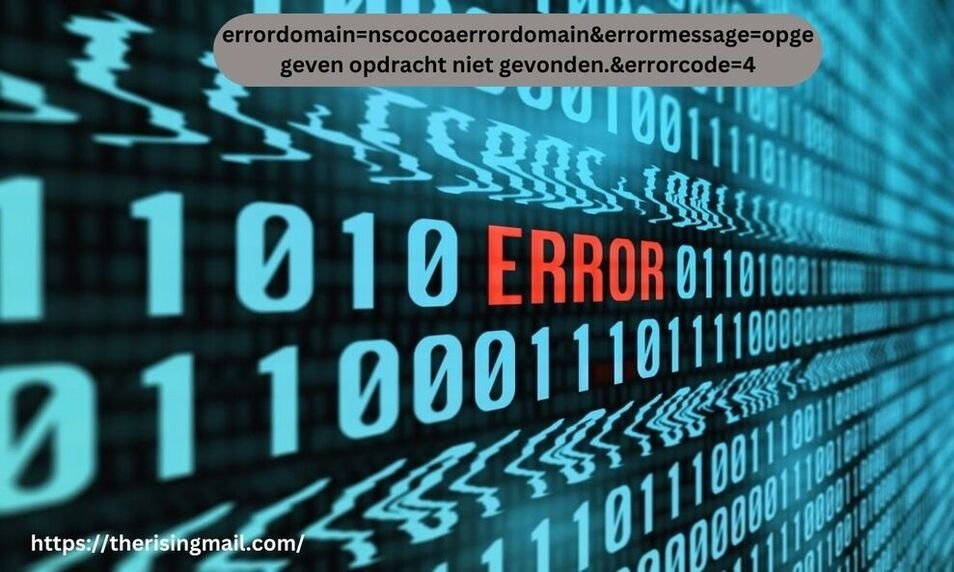Overview
Are you having trouble understanding an error message that appears to be incomprehensible? You’re not alone, so don’t worry. Many developers run into cryptic error messages that might be confusing. Especially those who are new to developing for iOS and macOS. We’re going to solve one such enigmatic error today:
This post will analyze this error message, clarify its meaning. And offer workable fixes to assist you in getting your code back on track. Regardless of your level of experience, this tutorial will provide you the skills. You need to address this problem head-on.
errordomain=nscocoaerrordomain&errormessage=opgegeven opdracht niet gevonden.&errorcode=4 What Does It Mean?
First, let’s dissect the error message into its constituent parts:
Error Message: “opgegeven opdracht niet gevonden” . (Dutch for “specified command not found”) Error Domain: Errordomain=nscocoaerrordomain&errormessage=opgegeven opdracht niet gevonden.&errorcode=4is the error code.
The Cocoa and Cocoa Touch frameworks, which are essential to the development of. iOS and macOS, fall under the large group of mistakes known as NSCocoaErrorDomain. This error domain typically indicates that there was a problem with a fundamental system function.
If you’re not expecting it, the error message. “opgegeven opdracht niet gevonden” could be misleading because it’s written in Dutch. It means “specified command not found” in English. This suggests that the system is trying to find a command or activity that it is not aware of.
NSFileNoSuchFileError, which is linked to error code 4. Usually indicates that a file or directory wasn’t found at the given path.
Typical Reasons for This errordomain=nscocoaerrordomain&errormessage=opgegeven opdracht niet gevonden.&errorcode=4
Now that we know what the mistake is trying to tell us, let’s look at some typical causes for it to occur:
- Incorrect File Paths: It’s possible that you’re attempting to access a file or directory that isn’t present at the address you provided.
- Issues with Permissions: It’s possible that the app lacks. The appropriate authorization to open the file or carry out the desired action.
- Issues with Localization: The Dutch error message indicates that there. May be a discrepancy between the app’s localization and the system language settings.
- Outdated or Incompatible Libraries: Third-party libraries and frameworks. You use may not work with the iOS or macOS version you’re currently using.
- Problems with code signing certificates can occasionally result in unforeseen failures. Particularly when working with file system activities.
- Sandbox Restrictions: Your software may be attempting to access resources outside. Of its permitted domains if it is sandboxed, which is a prerequisite for software Store distribution.
How to Correct the Error “Opgegeven Opdracht Niet Gevonden”?
Now let’s look at some doable actions you can do to fix this error:
1. Verify Your File Paths Again
Pointing to an invalid file or location is the most frequent source of this issue. Here’s how to make sure your file paths are correct:
Be sure you’re using the right path, and keep in mind that the directory structures of apps for macOS and iOS differ. To obtain the right paths for the directories in your program, use FileManager:
2. Confirm and Make Permission Requests
If your application requires access to specific system resources. Confirm that you have included a request for the required permissions in your Info.plist file. For instance, the NSPhotoLibrary. UsageDescription key must be included in order to access the photo library.
You can ask for authorization to use the photo collection in the following ways:
3. Verify the Localization of Your App
The error message in Dutch implies that there might be a problem with localization. Make sure you’re handling several languages. Correctly and that your program is appropriately localized. Here’s how to obtain localized strings in an easy way:
4. Revise Your Reliances
Assuming you are using Carthage, Swift Package Manager, or CocoaPods, confirm that all of your dependencies are current:
- Regarding CocoaPods:
- Update on pods for Carthage:
- Updates from Cairo
- In Xcode, update your package versions for the Swift Package Manager.
5. Check the Code Signing
Verify the code signing configuration in Xcode. Make sure you have the right team and provisioning profile selected by going to the “Signing & Capabilities” tab on your target.
6. Examine your Sandbox rights
If your program is sandboxed, confirm that you have the required permissions enabled. This may be done in Xcode by going to the “Signing & Capabilities” page for your target. Typical rights consist of:
- com.apple.security.files.read-only.user-selected
- The user-selected files in com.apple.security.read-write
- Network Client com.apple.security.network
7. Use Appropriate Error Management
Incorporate strong error handling into your code to help with error understanding and diagnosis. As an illustration, consider this:
8. Employ Debugging Instruments
Xcode offers robust debugging tools to assist in locating errors:
- In order to analyze variables and interrupt code execution. Set breakpoints in your code.
- To see the system logs, use the Console app.
- Add environment variables to your scheme settings. To enable verbose logging for your application.
9. Look for Problems Across the Board
Occasionally, problems with the system may be the root of the mistake instead than your application. Try these actions:
- Restart your simulator or development device.
- In Xcode, go to File > Packages > Clean Build Folder to clear the generated data.
- Use Disk Utility to fix disk permissions if you’re using macOS.
Ask for Assistance from the Community
Please do not hesitate to contact the developer community if you are still stuck:
- Ask a query on Stack Overflow and include a bare-bones replicable example.
- For information on related problems and fixes, visit Apple’s developer forums.
- For peer support, join social media networks’ iOS and macOS development communities.
Conclusion
In conclusion, effective troubleshooting in macOS and iOS. Software requires an understanding of NSCocoaErrorDomain failures. Including the specific error message “errordomain=nscocoaerrordomain&errormessage=opgegeven opdracht niet gevonden.&errorcode=4. Through the implementation of best practices, methodical troubleshooting procedures. And use of accessible resources, developers can proficiently address. And avert NSCocoaErrorDomain issues, hence guaranteeing the resilience and dependability of their programs.
FAQ
Let’s talk about some commonly asked questions about the “opgegeven opdracht niet gevonden” . Message and NSCocoaErrorDomain errors:
1. Why is the error notice written in Dutch?
A1: The error message (“opgegeven opdracht niet gevonden”) in. Dutch indicates that the framework you’re using, or your system. May have Dutch localization enabled. This may occur if:
The language on your development machine is Dutch.
Your current application or framework is set to use Dutch by default.
The system language and the localization settings for your program aren’t compatible.
Make sure your app’s localization is configured appropriately and. Check your system language settings to resolve this.
Q2: In NSCocoaErrorDomain, what does error code 4 mean?
A2: Generally speaking, error number 4 in the context of. NSCocoaErrorDomain corresponds to NSFileNoSuchFileError. When a file or directory at the supplied path cannot found by the system, an error occurs. Usually, it is caused by:
erroneous file paths
Files that relocated or erased
Problems with permissions prohibiting access to the file
Make sure your app has the right permissions to access the files it requires by always checking the paths to your files twice.
Q3: What is a better way to troubleshoot errordomain=nscocoaerrordomain&errormessage=opgegeven opdracht niet gevonden.&errorcode=4?
A3: For more efficient debugging of NSCocoaErrorDomain errors:
In Xcode, use breakpoints to halt execution at crucial moments.
Print comprehensive error details, such as the error code, domain, and localized description.
To see logs for the entire system, use the Console program.
Add environment variables to your scheme settings to enable verbose logging for your application.
To profile your application and find performance problems. That may be associated with file operations, use tools such as Instruments.
Also Read About – 127.0.0.1:62893 : Explained Troubleshooting Common Errors


